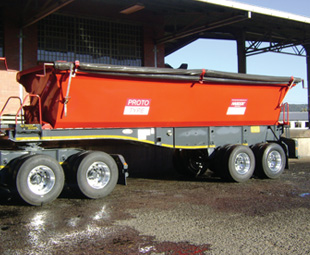Tipping the scales

Sweden has long been synonymous with products of strength and quality, and Swedish steel is no different. As the intellectual property of Swedish-based manufacturer SSAB, strong and durable Swedish steel has revolutionised heavy industries across the world. Now, through a partnership with SA Truck Bodies, it looks set to transform local transport as well.
To understand the impact that SA Truck Bodies’ new design will have on the local transport industry, it’s necessary to understand the trailer market and how the material amd design of a trailer impact payload capabilities.
Each trailer, be it a tanker, tipper or interlink, is designed for a specific payload. How the trailer is designed, what materials are used and how big it is depend on what is being carried. Is the load abrasive, heavy or reasonably light? How will it be loaded and unloaded?
Consumables tend to be transported by interlink trailers; fuel, chemicals, liquids and bulk powders in tankers; and construction materials, minerals and raw materials in tippers.
In fact, generally speaking, tippers tend to carry the heaviest, most abrasive loads, which are roughly loaded and offloaded as well. This combination of weight and material properties means that tippers need to be strong enough to handle their loads, while still light enough to ensure maximum payload.
There are a variety of tippers on the market, each made of different materials and following slightly different designs, which focus on specific applications and maximising payload efficiency. Now, SSAB and SA Truck Bodies are introducing a new design to the market that combines strength and durability with a revolutionary lightweight design.
“One of the most important decisions an operator and body builder can make is which trailer would best suit a specific application,” states Ricardo de Villiers, regional technical manager at SSAB.
“The material used and how a trailer is designed based on this material work together to form the basis of the perfect trailer, which should not only perform better for longer, but offer maximum payload results as well.”
Which is why SSAB decided to enter the local tipper market in February this year. “We are the manufacturer of Hardox wear plate,” explains De Villiers. “We supply our product to a variety of industries and companies across 45 different countries, mainly to the mining and construction industries where the strength and durability of Hardox plays a big role, but we wanted to branch out from supplying other manufacturers with our product, to actually being involved in the creation of something ourselves.”
The creation De Villiers is speaking of turned out to be a revolutionary tipper concept. “The concept of SSAB being involved in designing and manufacturing tipper trailers is hardly a new one,” he reveals. “Our unique and patented Hardox steel is a lightweight, thin, yet extremely tough steel, perfect for this very application.
“The product and brand have become so well known throughout Europe, that many operators will only transport goods using a tipper or trailer made from Hardox,” he continues. “The strength and durability of this particular alloy speaks for itself over there.”
It was therefore only a matter of time before Hardox premiered in South Africa and the local branch of SSAB expanded its range of operations to include tippers. However, thanks to a close partnership with SA Truck Bodies, the Swedish steel manufacturer’s involvement in the commercial transport industry was about to be taken to a whole new level, with an innovative tipper design that would not have been possible without the unique properties of Hardox.
According to Louis van Dyk, SA Truck Bodies’ design engineer, the trailer and body manufacturer had been working on a new tipper design that was lighter, yet as durable, as current tippers on the market. Swedish steel seemed the way to go, and so SSAB approached SA Truck Bodies and Van Dyk, and together produced a prototype sidetipper. SSAB’s involvement in the process was critical, as the company is not only the producer of the Hardox grade, but the expert in its application as well.
“We needed to reduce weight while increasing strength – no easy task,” admits Van Dyk. “We had been toying with the idea of welding ribs along the sides of our tipper prototype, but this involved extra processes and three separate panels that needed to be welded together, opening up the possibility of cracked or skewed panels.
“And then SSAB supplied us with four full-length, 7.5-m sheets. This allowed us to create two 7.5-m bins that had no extra ribbing or welding.”
However, as with any new design, there was another challenge.
“One of the strengthening factors of Swedish steel is created through bending the alloy in specific places along the sides of the tipper,” De Villiers explains. “Traditionally, a steel tipper would require a number of bends, which narrow as the sides of the tipper near the trailer’s floor, to give the design additional support.”
While this is certainly true, SA Truck Bodies would find bending the 7.5-m-long steel sheets incredibly challenging.
“We couldn’t bend them, which meant we couldn’t design the tipper bins from single sheets,” says Van Dyk. Or could they?
Upon contacting SSAB, the body builder was advised that due to the nature of Hardox, the steel would be durable enough to withstand the riggers of a tipper without any supporting bends in the design.
“Without bends, less steel can be used to make a smaller, lighter trailer that still offers the same payload advantages of its predecessors,” boasts De Villiers. “SA Truck Bodies’ prototype trailer is made from two 7.5-m-long bins that each carry 18 t. Two bins are necessary so that one is balancing the entire rig while the other is tipping a load, and a 36-t payload is more than good enough for our local regulations and applications.”
The prototype is currently being tested by a local transport company that transports a range of different products.
“We want to see what kind of abuse the tipper bins can handle based on this new, lightweight design,” he explains. “We need it to be tested in extreme conditions, with heavy abrasive loads. Each bin is made of two sheets that overlap each other along the centre of the bins’ floors. We are expecting the sidewalls of the bins to withstand immense pressure based on the unique properties of Hardox.”
An added bonus for operators is the smooth side of the tipper that lends itself to company branding. Without the traditional bends in the steel needed to strengthen the design, operators quite literally have two 7.5-m canvasses with which to work.
“We are extremely proud of SA Truck Bodies’ design,” reveals De Villiers. “Together, our expertise in steel and their knowledge of trailers has produced an innovative and exciting new model that is strong, yet much lighter than any steel tipper trailers have ever been.
“It’s a fantastic progression of our position in this market, just a few short months after launching Hardox in the transport sector in South Africa. We have no doubt the brand will soon gain its rightful place in local commercial transport terminology and operations.”
Published by
Focus on Transport
focusmagsa





 FUSO: Driving the Future of Mobile Healthc
FUSO: Driving the Future of Mobile Healthc



 New Electric Van Range Unveiled!
New Electric Van Range Unveiled!  A brand
A brand




 Wondering about the maximum legal load for a
Wondering about the maximum legal load for a 
 The MAN hTGX powered by a hydrogen combus
The MAN hTGX powered by a hydrogen combus


 Exciting News for South African Operators
Exciting News for South African Operators






